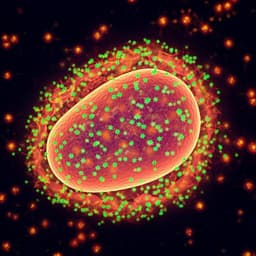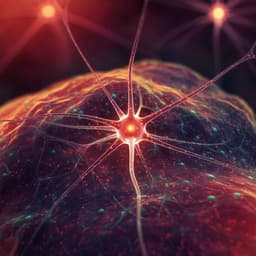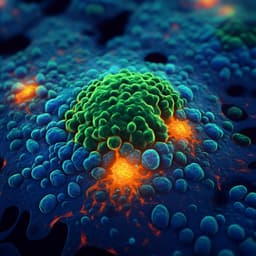
Medicine and Health
Longitudinal single-cell profiling of chemotherapy response in acute myeloid leukemia
M. M. Naldini, G. Casirati, et al.
Discover groundbreaking research into acute myeloid leukemia (AML) that identifies leukemia stem cells (LSCs) using innovative techniques like single-cell RNA sequencing. This study reveals insights into chemotherapy responses and their implications for patient survival, conducted by a team of expert researchers including Matteo Maria Naldini and Gabriele Casirati.
~3 min • Beginner • English
Introduction
The study addresses why standard induction chemotherapy frequently fails in acute myeloid leukemia (AML), focusing on the role of leukemia stem cells (LSCs) in early therapy resistance and disease regeneration. While early treatment failure is often attributed to resistant subclones with high leukemia-regenerating capacity, and relapse may originate from minimal residual disease persisting in dormant states or sanctuary sites, definitive prospective identification and longitudinal tracking of resistant LSCs at single-cell resolution has been challenging. Conflicting models propose either efficient LSC depletion with transient regenerative responses or chemotherapy-induced senescence leading to enhanced stemness. The authors hypothesize that longitudinal single-cell profiling of AML before and early after chemotherapy, combined with stringent LSC identification via a miR-126 activity reporter and clonal/variant tracking (NPM1 mutations or chr7 monosomy), would clarify LSC dynamics, transcriptional programs, and their contribution to resistance and relapse.
Literature Review
Prior work suggests therapy-resistant cells can pre-exist at diagnosis and drive relapse, but prospective identification is difficult. Studies reported that cytarabine may deplete LSCs in vivo with a transient leukemia-regenerating, OxPhos-dependent proliferative response (leukemia-regenerating cells), challenging the classical hierarchical LSC model. Other findings describe chemotherapy-induced cellular senescence that reprograms differentiated tumor cells towards enhanced stemness and in vivo propagating capacity upon senescence escape, implying AML cell plasticity between primitive and differentiated compartments. The authors previously linked miR-126 tightly to HSC/LSC function, quiescence, and chemotherapy resistance, and developed a miR-based prognostic score including miR-126. Ectopic miR-126 expression can induce leukemia in murine models. Lentiviral miRNA-responsive reporters enable live monitoring and selection of LSC-enriched subpopulations. Focusing on NPM1-mutated and del(7) AML subtypes leverages defined genetic contexts for unambiguous malignant cell identification (NPM1 mutation reads, chr7 monosomy) at single-cell level.
Methodology
- Patient cohorts: 10 patients with NPM1-mutated AML (spanning refractory, early relapse, and long-term CR outcomes) and 3 patients with del(7) AML. Samples collected at diagnosis and post-induction days 14 and/or 30. Clinical details in supplementary data.
- Malignant cell identification: In scRNAseq, AML cells were distinguished from normal hematopoiesis using single-cell NPM1 mutation calling (NPM1-MF algorithm) or chr7 gene module score for del(7), coupled with cluster-based assignment and lineage annotations, ensuring exclusion of non-malignant HSC/SRC.
- Single-cell RNA sequencing: 10x Genomics 3' libraries (v2/v3) on sorted leukemia-enriched BM/PB cells; processed with Cell Ranger and Seurat; batch correction using Harmony; UMAP embedding; Louvain clustering (resolution 0.6; subclustering as needed); pseudotime with Monocle3; module scores for signatures (e.g., 126High, 126Low); cell cycle inference; GSEA (MSigDB Hallmarks) and GO over-representation analyses.
- Xenograft models (PDX): NSG/NSGW41 mice transplanted with primary AML. A lentiviral miR-126 sensor (GFP 3'UTR with miR-126 target sites and mCherry/dNGFR control under bidirectional promoter) allowed flow cytometric readout of miR-126 activity (GFP downregulation indicates miR-126high). Limiting-dilution serial transplantation quantified leukemia-initiating cell (LIC) frequencies in sorted GFP-low (miR-126high) vs GFP-high (miR-126low) fractions.
- In vivo chemotherapy: PDX mice treated with daunorubicin (1.5 mg/kg, days 1–3) and cytarabine (60 mg/kg, days 1–5); controls received saline. Early post-treatment analysis at day 8: blast burden, immunophenotype (CD34+CD38−), miR-126 activity distribution, EdU incorporation (days 4–7), and scRNAseq profiling of residual blasts (bulk and sorted miR-126high cells) with HTO hashing for sample demultiplexing.
- Bulk RNA-seq of sorted PDX fractions: Transcriptomes of GFP-low/miR-126high vs GFP-high/miR-126low subpopulations at baseline and post-chemotherapy; DESeq2 for differential expression; GSEA/GO analyses to define 126High (989 upregulated genes) and 126Low signatures.
- OxPhos perturbation: Ex vivo treatment of primary AML blasts with IACS-010759 (ETC complex I inhibitor), alone or with cytarabine; assessment of miR-126 activity and in vivo repopulation capacity upon transplantation.
- Survival analysis: Reduction of 126High to a 24-gene informative panel via item-test correlations in scRNAseq; Cox proportional hazards with lasso penalty on three independent AML datasets (GSE12417/GSE37642 microarrays, OHSU RNA-seq, TCGA), training/testing using categorized expression to define risk groups and evaluate overall survival stratification.
- Statistics: Linear mixed-effects models for PDX comparisons; nonparametric tests (Wilcoxon, bootstrap where applicable); multiple-testing correction (Benjamini–Hochberg, Holm).
Key Findings
- LSC identification and enrichment: A lentiviral miR-126 reporter prospectively enriches for LSCs in NPM1-mutated AML xenografts. GFP-low/miR-126high fractions showed up to ~20-fold higher LIC frequency by limiting dilution. Across patient-derived fractions, miR-126 activity quantitatively correlated with LIC frequency (Spearman rho = 0.93, p = 0.00013).
- Chemotherapy responses at single-cell resolution:
• NPM1-mutated AML: Day 14 residual blasts showed proliferative/OxPhos hallmark upregulation outside early progenitors, while early progenitors displayed low OxPhos and cell-cycle programs with enriched inflammatory signatures. By day 30, residual progenitors remained metabolically inactive (low OxPhos/glycolysis) with attenuated inflammation.
• del(7) AML: Day 14 revealed broad proliferative and OxPhos upregulation across progenitors; by day 30 these hallmarks decreased, with progenitors persisting and differentiated myeloid cells diminishing. Inflammatory programs remained elevated.
- Divergent progenitor vs LSC behavior: scRNAseq in PDX at day 8 post-chemotherapy showed expansion of differentiated myeloid/erythroid-like blasts, stable HSC-like compartment proportionally, and a bimodal 126High signature distribution—reduced in most blasts but preserved in a distinct subpopulation (miR-126high LSCs). Progenitor clusters upregulated energy and cell-cycle pathways; HSC-like LSCs downregulated OxPhos and MYC responses, consistent with quiescence.
- LSC transcriptional programs: miR-126high cells enriched for HSC/LSC signatures and unexpectedly for lymphoid genes (RAG1/2, DNTT, CD79A/B, ZAP70, CD7) at baseline and post-chemotherapy; miR-126low cells enriched for myeloid effector and cycling programs.
- Inflammatory/senescence response: Chemotherapy induced TNF/NFKB- and interferon-driven inflammatory and senescence-associated gene signatures across AML compartments in PDX and patient samples.
- Refined LSC subclusters: Within HSC-like blasts, chemotherapy enriched subclusters (e.g., 6′, 19′) expressing LSC-associated genes (CD34, CD36, CD99, GUCY1A1, TNFRSF4, DNTT) and HSC latency marker INKA1, with low CDK6, indicating dormant LSC states.
- OxPhos inhibition selects LSCs: IACS-010759 treatment increased miR-126 activity and markedly enhanced subsequent in vivo repopulation, indicating functional enrichment of OxPhoslow, miR-126high LSCs.
- Prognostic 126High signature: Mapping 126High to patient scRNAseq localized LSCs within early progenitor clusters. At diagnosis, higher prevalence and expression levels of 126High were observed in refractory/early relapse patients vs long-term CR. A reduced 24-gene 126High panel stratified overall survival across independent AML cohorts (training GSE12417/GSE37642; testing OHSU) with significantly separated Kaplan–Meier curves (log-rank p < 0.0001 training; p = 0.0343 testing).
- Enrichment during therapy and relapse: miR-126high LSC clusters increased during induction chemotherapy (days 14/30) and were further enriched at relapse. Relapse samples showed co-existence of stemness and proliferation (elevated OxPhos, DNA repair; reduced inflammatory/p53), whereas chemotherapy-refractory relapse post-reinduction reverted to quiescent, stress/inflammation-enriched 126High states.
Discussion
The study demonstrates that LSCs persist through induction chemotherapy and are central to early therapy resistance in AML, particularly in NPM1-mutated disease. Single-cell analyses reveal two divergent post-chemotherapy trajectories: a regenerating OxPhoshigh, proliferative progenitor compartment and a quiescent, inflammatory miR-126high LSC compartment that maintains stemness. This reconciles prior conflicting models by showing that chemotherapy can deplete and trigger proliferation in committed blasts while sparing dormant LSCs that exhibit senescence-like and inflammatory programs. The tight quantitative link between miR-126 activity and LIC function, and the robust prognostic performance of the 126High gene signature across large cohorts, highlight miR-126high LSCs as clinically relevant drivers of treatment failure and relapse. The identification of lymphoid-biased transcriptional features within LSCs suggests broader immunotherapeutic targetability (e.g., CD7, TNFRSF4). The relapse state shows increased proliferation and OxPhos dependency across clusters, implying stage- and subtype-specific vulnerabilities (e.g., ETC inhibition effective in poor-outcome AML) and underscoring that strategies effective at relapse may differ from those needed to eradicate dormant LSCs at induction.
Conclusion
This work integrates longitudinal patient and PDX single-cell transcriptomics with functional LSC assays to show that miR-126high, OxPhoslow, quiescent LSCs persist early after induction chemotherapy, expand relatively to the bulk, and are enriched in refractory and relapsed AML. A miR-126–derived LSC signature precisely maps these cells in scRNAseq, stratifies patient survival across independent cohorts, and refines the cellular hierarchy underlying resistance. Therapeutically, combining agents active against dormant LSCs (e.g., miR-126 targeting, BCL2 inhibition) with chemotherapy directed at proliferating blasts may improve outcomes. Future work should enable prospective clinical quantification of miR-126high LSCs at diagnosis for risk-adapted therapy, perform lineage-tracing to definitively link persistent LSCs to relapse, and systematically evaluate targeted interventions against the inflammatory/senescence and WNT–MYC programs identified in LSCs.
Limitations
- Cohort size and scope: A relatively limited number of patients (NPM1-mutated and del(7) subtypes) were studied, which may affect generalizability across all AML subtypes.
- Causal inference and lineage tracing: The study lacks longitudinal single-cell lineage tracing of individual LSCs; thus, while data strongly suggest persistence of quiescent LSCs and their enrichment at relapse, it does not directly prove that relapse derives from specific LSCs persisting through induction.
- Model constraints: Some mechanistic insights rely on xenograft models, which may not fully recapitulate human microenvironmental influences; scRNAseq technical limitations (dropouts) required cluster-based AML assignment in part of cells.
- Therapeutic translation: While OxPhos inhibition and miR-126 modulation experiments suggest vulnerabilities, comprehensive in vivo efficacy and safety in diverse AML contexts require further validation.
Related Publications
Explore these studies to deepen your understanding of the subject.







